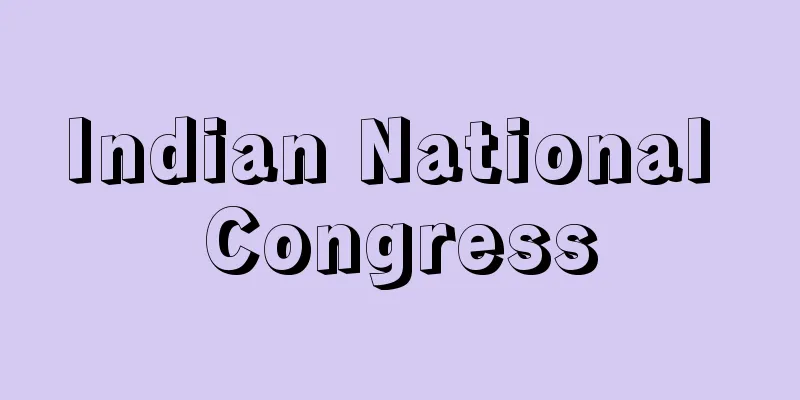Indian National Congress

|
The leading political party in India. Also known as the Congress or the Congress Party. [Kousuke Furuse] From its establishment to Indian independenceThe All-India National Congress was convened at the end of 1885 by retired British civil servant Allan Octavian Hume (1829-1912) in anticipation of the nationalist movement that was beginning to take shape in the Bengal region at that time. Most of the participants in this Congress were Hindu intellectuals and landowners. However, the strengthening of British colonial rule, which was clearly expressed in the passage of the Bengal Partition Act in 1905, gave rise to "extremists" within the Congress Party. Instead of the "moderates" W.C. Banerjee and G.K. Gokhale, B.G. Tilak, B.C. Bipin Chandra Pal (1858-1932), L.L. Rai and others became influential and began to advocate xenophobia, such as swaraj (self-governance) and swadeshi (use of domestically produced goods), as well as the rejection of British currency. The Congress's history has been marked by internal conflicts, divisions, and the creation and emergence of new parties, but overall the party's influence has continued to grow and it has developed into India's foremost national political party. After World War I, the Congress Party maintained close ties with the nonviolent independence movement and social reform movement led by Mahatma Gandhi. On the one hand, the Congress Party followed Gandhi's line in the struggle against Britain, participating in the first nonviolent struggle in the early 1920s, declaring "Pourna Swaraj" (complete self-government) at the Congress Party's Lahore Conference in 1929, participating in the second nonviolent struggle in the early 1930s, refusing India's automatic entry into World War II in the early 1940s, and passing the "Quit India" resolution in 1942. In terms of social reform, the Congress Party also incorporated and implemented each item of Gandhi's "constructive program" into its party platform at the appropriate time. During this time, the Congress Party grew into a national party that could mobilize the peasant masses in Indian villages. [Kousuke Furuse] After Indian IndependenceAfter the Second World War, India achieved independence on August 15, 1947, in the form of separation from Pakistan, in a turbulent period of domestic and international affairs. The Congress Party, which played a decisive role in this process, won a landslide victory in the first general election after the Indian Constitution was enacted on January 26, 1950. Under the Nehru administration, India actively promoted its own peaceful diplomacy based on non-alignment, signing the Japan-India Peace Treaty, and hosting the Bandung Conference, following the peace proposal in the Korean War. In domestic affairs, while maintaining parliamentary democracy, it formulated and implemented five-year economic plans, and undertook social, cultural, and educational reform projects, and began building a "socialist society." After Nehru's death (May 27, 1964), his daughter Indira Gandhi became Prime Minister in 1966. It can be said that the Congress Party cabinet she organized followed the basic policy promoted by Nehru. However, in the sixth general election in 1977, the right-wing Congress Party led by M. Desai, who had long opposed Indira Gandhi's authoritarian rule, formed the new Janata Party (People's Party) together with the Socialist Party, Jan Sangh, and BLD, and won a landslide victory, causing the Congress Party (Indira faction) to become a minority party for the first time in history. Of these, the Jan Sangh is a Hindu supremacist communal party (religious sect) formed in 1951, which descended from the Hindu Mahasabha founded in 1913 and had deep ties with the Rashtriya Sangh (RSS). After the Janata Party joined the government, it changed its name to the Bharatiya Janata Party (BJP). The BLD was formed in August 1974 when the Bharatiya Janata Party (BKD), which represented the middle class of farmers in the northern Indian state of Uttar Pradesh, merged with the Swatantra Party (Liberal Party) and others. After that, internal conflicts within the M. Desai cabinet continued, and in the seventh general election in 1980, the Indira faction again won a landslide victory, and the Janata Party lost a large number of seats not only at the national level but also in state assemblies. However, anti-government protests by Sikhs, mainly in Punjab state, intensified, and in June 1984 government forces blew up the Golden Temple, the headquarters of Sikhism in Amritsar, culminating in the assassination of Prime Minister Indira Gandhi on October 31 of the same year. Meanwhile, regionalist movements in southern Indian states that took an anti-central and anti-Congress stance were also gaining momentum, and the future of the newly formed government of Indira's eldest son, Rajiv Gandhi, was by no means smooth. [Kousuke Furuse] The party's declineThe Congress Party (Rajiv's faction) won a landslide victory in the December 1984 general election, winning 401 of the 508 seats up for election, but subsequent worsening economic conditions and corruption scandals caused rifts within the party, leading to a major defeat in the November 1989 general election. Then, after the short-lived and unstable government of the new centrist party, the Janata Dal, resigned, Rajiv Gandhi was assassinated in a bomb attack by a person believed to be a Tamil extremist during the 10th general election on May 21, 1991. The election resulted in a narrow victory for the Congress Party, leading to the birth of the government of N. Rao PV Narasimha Rao (1921-2004). The Rao administration revised the Congress Party's previous socialist planned economy and business licensing system that emphasized the state-run sector, and introduced major economic liberalization and privatization in the industrial and financial sectors. However, while the Bharatiya Janata Party (BJP), the largest opposition party in the lower house, was gaining ground, and the government struggled to respond to the religious conflict and riots between Muslims and Hindus that had been triggered by the Ayodhya incident on December 6, 1992, in which approximately 200,000 Hindus destroyed an Islamic temple in the holy city of Ayodhya in central India, a donation scandal came to light in June 1993. Prime Minister Rao faced a motion of no-confidence in his cabinet, which he finally managed to get rejected, but the foundation of the Rao administration was greatly shaken, and the Congress Party suffered crushing defeats in the local elections in November of the same year and in nine state assembly elections in March 1995. On May 19 of the same year, the expulsion of anti-Prime Minister Rao faction gave birth to the Tiwari faction, further strengthening the Congress' tendency to split. [Kousuke Furuse] The rise of the People's PartyIn the general elections held from April to May 1996, the Bharatiya Janata Party (BJP) finally defeated the Congress Party to become the largest party, and formed a cabinet headed by President A.B. Vajpayee, but it did not gain the confidence of Parliament and was short-lived, lasting only 13 days. The D. Gowda cabinet was then formed by a center-left alliance known as the "United Front," but this too was forced to resign en masse in April the following year, 1997, and the next cabinet, the I. Gujral United Front cabinet, also fell in November of the same year when its coalition with the Congress Party was dissolved. In fighting the 12th general election in March 1998, the Congress Party reaffirmed the basic line it had taken, while the xenophobic Hindu supremacist Bharatiya Janata Party and its sympathizers were expanding their influence and gaining more support from the public. Building on its traditions and achievements, the Congress Party presented concrete measures to solve domestic and international political issues in an attempt to gain support from all segments of the public, but the election ended in defeat, with the Congress Party losing 142 seats to the Bharatiya Janata Party's 179, and it was unable to halt its downward trend, just as in the previous election. The Bharatiya Janata Party, which became the largest party in the Lower House, formed a coalition government and immediately afterwards carried out nuclear tests on May 11 and 13, 1998. It also announced its intention to officially join the global nuclear group, sending shock waves both at home and abroad. As a result, the peaceful use of nuclear energy, one of the basic policies that the Congress Party had traditionally followed, was abandoned. In addition, the fundamental principles that the Congress Party had upheld and practiced, such as the elimination of exclusive communalism (religious sectarianism) as a prerequisite for parliamentary democracy, the principle of separation of church and state (secularism), and development through the assurance of stability, are being denied in Indian politics. Sonia Gandhi (1946-), wife of the assassinated former Prime Minister Rajiv Gandhi, had refused to enter politics despite the party's strong request, but she participated in the 1998 election and was praised for putting a stop to the Congress Party's downward trend, and she became the party's president in April of the same year. However, in the October 1999 general election, the ruling coalition "National Democratic Alliance" led by the Bharatiya Janata Party under interim Prime Minister Vajpayee won 296 seats, while the Congress Party and friendly parties won 134 seats, resulting in the victory of the Bharatiya Janata Party. In the May 2004 general election, the Bharatiya Janata Party led by Vajpayee was defeated, and the Congress Party became the largest ruling party. The Congress Party unanimously elected its president, Sonia Gandhi, as its parliamentary leader, and it was expected that she would become prime minister, but she declined. Manmohan Singh became prime minister. He is India's first Sikh prime minister, and has held many important positions in the economic field in the past, including finance minister in the Rao cabinet and economic advisor to the Gandhi governments of Indira and Rajiv. He announced that he would continue with economic reform, poverty alleviation, and dialogue with Pakistan, and served two terms, but stepped down after the May 2014 general election. Narendra Modi (1950- ), leader of the Bharatiya Janata Party, won the election and became prime minister. If we include Nehru's father, Motilal Nehru, who was active in the early stages of the Congress Party and was on friendly terms with Mahatma Gandhi, the role and contributions of the Nehru family throughout the Congress Party's century-long history are enormous and unparalleled. In particular, the ability and prestige of Prime Minister Jawaharlal Nehru, who was the leader (president) of the largest ruling party in Indian politics after independence and took sole charge of India's domestic and foreign affairs, and the "Nehru dynasty" that continued through his daughter Indira and grandson Rajiv for three generations, cannot be thought of without taking into account India's traditional political culture (charisma and lineage/hereditaryism) that underlies the caste system. [Kousuke Furuse] OrganizationThe Congress Party has decision-making and executive bodies at the national, state, local and territory levels. At the national level, there is the All India Congress Committee (AICC), its Executive Committee, the Secretariat Committee, the External Affairs Department, the Computer Bureau Committee, and as frontline organizations, the Indian Youth Congress, the Indian National Students Federation and the Indian National Trade Union Congress. At the state and local levels, there are state and local Congress committees, and there are Congress committees in six territories, including Nicobar Islands and Chandigarh, with branches in each state. Members are selected through elections, and they work together in the local party organizational networks at each level to campaign for elections, expand the party's influence on a daily basis, collect party dues and so on. The Congress Party, as a national party, has many tasks to accomplish, such as restoring the numerical and qualitative organizational strength of the Party, which boasted 4 million members before the split, purifying the organization and establishing functionalism, and improving cooperation between the central and local organizations. However, it is also desirable to create a new image of a party that appeals directly to the masses and to create a guiding principle for it. [Kousuke Furuse] "Modern Indian Politics and Society" by Sakamoto Tokumatsu (1969, Hosei University Press)" ▽ "Modern World History 9: Modern South Asian History I: India" by Nakamura Heiji (1977, Yamakawa Publishing)" ▽ "History of Countries around the World: History of India" edited by Yamamoto Tatsuro (1985, Yamakawa Publishing)" ▽ "Modern Indian Politics: Its Light and Shadow" by Kimura Masaaki (1996, Sekaishisosha)" ▽ "Annual Editions of the Asian Trends Annual Report (Institute of Developing Economies)" [References] | | | | | | | | | | | | | | | | | | | |Source: Shogakukan Encyclopedia Nipponica About Encyclopedia Nipponica Information | Legend |
|
インドの代表的政党。会議派(コングレス)、会議派党とも略称。 [古瀬恒介] 成立からインド独立まで1885年末、当時ベンガル地方を中心として胎動し始めていた民族主義的運動を先取りする形で、イギリスの退役官吏のA・O・ヒュームAllan Octavian Hume(1829―1912)が呼びかけて招集された全インド国民会議All-India National Congressが発端。この会議への参加者はほとんどがヒンドゥーの知識人・地主層であった。しかし、その後、たとえば1905年のベンガル分割法の通過にはっきり表明されたイギリス植民地主義支配の強化は、会議派内部にも「過激派」を生み出した。「穏健派」のW・C・バネルジー、G・K・ゴーカレーらにかわって、B・G・ティラク、B・C・パールBipin Chandra Pal(1858―1932)、L・L・ラーイらが有力になり、スワラージ(自治)、スワデーシー(国産品愛用)とともに英貨排斥といった排外主義的な主張を始めた。会議派の歴史には、その後も内紛、分裂、新党の派生・誕生が繰り返されるが、全体として党勢は伸び続け、インド第一の国民政党として発展した。 第一次世界大戦後、会議派はマハトマ・ガンディーの指導する非暴力的独立運動および社会改革運動と密接な関係を保った。つまり一方で、1920年代初頭の第一次非暴力闘争への参加、1929年会議派ラホール大会での「プールナ・スワラージ」(完全自治)宣言、1930年代初頭の第二次非暴力闘争への参加、1940年代初頭における第二次世界大戦へのインドの自動的参戦拒否、1942年の「インドを撤退せよ」決議など、対英抗争の面でガンディーの路線に従ったばかりか、社会改革の面でも会議派は、彼の「建設的プログラム」の各項目を適時党綱領に取り入れ実行した。その間に会議派は、インド村落の農民大衆をも動員しうる国民政党へと成長していった。 [古瀬恒介] インド独立以後第二次世界大戦後インドは、内外情勢の交錯する動乱期に、パキスタンと分離する形をとって1947年8月15日に独立を達成した。この過程でも決定的な役割を果たした会議派は、1950年1月26日のインド憲法施行後、第1回総選挙において圧勝し、ネルー政権のもとで、対外面では、先の朝鮮戦争における和平提案に続いて、日印平和条約の調印、バンドン会議の主催と独自の平和外交、非同盟主義に基づく中立外交を積極的に打ち出した。内政面では、議会制民主制を堅持しつつ、経済五か年計画の立案実施、社会・文化・教育面での改革事業に取り組み、「社会主義型社会」の建設に着手した。ネルーの死(1964年5月27日)後、1966年にネルーの娘インディラ・ガンディーが首相の席についた。彼女が組織した会議派内閣においてもネルーが推進した基本路線は踏襲されてきたといえよう。 しかし、1977年の第6回総選挙にあたり、インディラ・ガンディーの強権政治にかねてから反対していたM・デサイらの右派国民会議派が、社会党、ジャン・サング、BLDとともに新たにジャナタ党(人民党)を結成し選挙に大勝し、会議派(インディラ派)は史上初めて少数党に転落した。このうち、ジャン・サングは1951年に結成されたヒンドゥー至上主義のコミュナル政党(宗教セクト)で、1913年創立のヒンドゥー大連合の流れをくみ、民族義勇団(RSS)とも深いつながりをもち、ジャナタ党政権参加後インド人民党(BJP)と改称した。BLDはインド北部ウッタル・プラデシュ州の中農層を代弁するインド革命党(BKD)が、1974年8月にスワタントラ党(自由党)などと合併して結成された政党である。 その後、M・デサイ内閣の内紛が続き、1980年の第7回総選挙では、ふたたびインディラ派が圧勝し、ジャナタ党は中央ばかりか、州議会においても議席数を激減させた。しかし、その後パンジャーブ州を中心とするシク教徒の反政府運動が激化し、84年6月ついに政府軍はアムリッツァルのシク教大本山ゴールデン・テンプル(黄金寺院)を爆破し、同年10月31日のインディラ・ガンディー首相暗殺へと事態は進展した。一方南インド諸州の反中央・反会議派の姿勢をとる地域主義の動きも活発化し、新しく誕生したインディラの長男ラジブ・ガンディー政権の前途は決して平坦(へいたん)ではなかった。 [古瀬恒介] 党勢の後退会議派(ラジブ派)は、1984年12月の総選挙では改選508議席中401議席を獲得し大勝したが、その後の経済情勢の悪化や汚職事件によって党内に亀裂(きれつ)が入り、1989年11月の総選挙で大敗した。そして、中道新党のジャナタ・ダルの短期不安定政権が退陣した後、1991年5月21日第10回総選挙の最中に、ラジブ・ガンディーはタミル人過激派とみなされる者により爆殺された。選挙の結果は会議派が辛勝し、N・ラオP. V. Narasimha Rao(1921―2004)政権の誕生となった。 ラオ政権は、それまでの会議派の社会主義的計画経済、国営部門重視の企業許認可制度を改めて、大幅な経済自由化、民営化を産業諸分野と金融面で打ち出した。しかし、下院野党第一党のインド人民党(BJP)の追い上げと、1992年12月6日にインド中部の聖地アヨーディヤーでヒンドゥー教徒ら約20万人がイスラム教寺院を破壊したアヨーディヤー事件をきっかけとしたイスラム、ヒンドゥー両教徒の宗教的な対立・暴動への対応に苦慮するなか、1993年6月に献金疑惑事件が発覚。ラオ首相は内閣不信任案を提出され、これをようやくにして否決にもち込んだものの、ラオ政権の基盤は大きく揺らぎ、同年11月の地方選、1995年3月の九つの州議会選挙で会議派は惨敗を喫した。同年5月19日、反ラオ首相派の除名処分により、ティワリ派が誕生し、会議派の分裂傾向は一段と強まった。 [古瀬恒介] 人民党の躍進1996年の4月から5月にかけて行われた総選挙において、インド人民党(BJP)がついに会議派を破って第一党となり、A・B・バジパイ総裁を首班とする内閣が成立したが、議会の信任を得られず13日の短命内閣に終わった。その後、中道左派連合の「統一戦線」によるD・ゴウダ内閣が発足したが、これも翌1997年4月総辞職に追い込まれ、次のI・グジュラル統一戦線内閣も同年11月に会議派との連立解消で倒れた。 1998年3月の第12回総選挙を戦うにあたって、会議派は排外主義的ヒンドゥー至上主義のインド人民党とその同調者たちがますます党勢を拡張し国民的支持を増やしつつあるなかで、改めて同党がとってきた基本路線を再確認した。その伝統と実績のうえに内外の政治課題を解決するための具体的施策を提示して、国民各層の支持を得ようとしたが、選挙の結果は敗北に終わり、会議派142対インド人民党179と前回と同様その低落傾向に歯止めをかけることはできなかった。 下院第一党となったインド人民党は、連立政権を樹立し、その直後の1998年5月11日と13日に核実験を強行。また、世界の核グループへの公式参加の意思を表明し、内外に大きな衝撃を与えた。これによって、会議派が従来とってきた基本路線の一つである原子力の平和的利用は破棄されることとなった。そのほか、議会制民主制の前提としての排他的コミュナリズム(宗教セクト主義)の排除、政教分離の原則(セキュラリズム)、安定性の確保による発展などこれまで会議派が掲げ実践してきた大原則がインド政治のなかで否定されようとしている。暗殺されたラジブ・カンディー元首相夫人のソニアSonia Gandhi(1946― )は党の強い要請にもかかわらず政界入りを拒んでいたが、1998年の選挙では運動に参加し、会議派の低落傾向に一応の歯止めをかけたことが評価され、同年4月には党総裁に就任した。しかし、1999年10月の総選挙では、バジパイ暫定首相を擁するインド人民党主導の与党連合「国民民主同盟」が296議席、国民会議派および友好政党が134議席という結果で、インド人民党の勝利に終わった。2004年5月のインド総選挙では、バジパイ率いるインド人民党は敗北、国民会議派が与党第一党となった。国民会議派は、同派の総裁であるソニア・ガンディーを全会一致で議員団長に選出、首相就任が確実視されたが、本人が辞退。マンモハン・シンが首相に就任した。インド初のシク教徒の首相であり、過去にラオ内閣時代の財務相、インディラとラジブのガンディー政権の経済顧問など経済分野の要職を多く務めた。経済改革、貧困対策、パキスタンとの対話路線の継続を表明し、二期を務めたが2014年5月の総選挙後に退任。選挙に勝利したインド人民党のナレンドラ・モディNarendra Modi(1950― )が首相に就任した。 このように会議派初期の段階で活躍し、マハトマ・ガンディーとも親交のあったネルーの父モーティーラール・ネルーを含めれば、会議派の1世紀に及ぶ歴史のなかで果たしたネルー家の役割と貢献は絶大でほかに類をみない。とりわけ独立後のインド政界で与党第一党の党首(総裁)としてインドの内政外交を一手に引き受けたジャワーハルラール・ネルー首相の力量と名声、その娘インディラと孫ラジブと続く3代にわたる「ネルー王朝」は、カースト制に通底するインドの伝統的政治文化(カリスマおよび血統・世襲主義)を抜きにしては考えられない。 [古瀬恒介] 組織会議派の党組織は、全国、州、地方、直轄領の各レベルでそれぞれ意思決定と実行機関をもつ。全国レベルでは、全インド会議派委員会(AICC)、同実行委員会、事務局委員会外務部、コンピュータ局委員会、それに前線組織として、インド青年会議、インド全国学生連盟、インド全国労働組合会議などがある。州、地方レベルでは、州会議派委員会、地方会議派委員会があり、ニコバル諸島、チャンディガルなど六つの直轄領にもそれぞれ会議派委員会を設け、各州に支部をもっている。メンバーの選出は選挙によって行われ、各レベルでの選挙のキャンペーン、党勢の日常的拡大、党費集めなど各地方の党組織網のなかで相互に連携しながら活動している。分裂前は党員数400万人を誇った会議派の数的・質的な組織力の回復、組織浄化と機能主義の確立、中央・地方組織の協力態勢の整備など、国民政党としての会議派のなすべき課題は多いが、一方で国民大衆に直接訴えかける新しい政党イメージの形成とその指導理念の創出が望まれる。 [古瀬恒介] 『坂本徳松著『現代インドの政治と社会』(1969・法政大学出版局)』▽『中村平治著『世界現代史9 南アジア現代史Ⅰ インド』(1977・山川出版社)』▽『山本達郎編『世界各国史 インド史』(1985・山川出版社)』▽『木村雅昭著『インド現代政治――その光と影』(1996・世界思想社)』▽『『アジア動向年報』各年版(アジア経済研究所)』 [参照項目] | | | | | | | | | | | | | | | | | | | |出典 小学館 日本大百科全書(ニッポニカ)日本大百科全書(ニッポニカ)について 情報 | 凡例 |
<<: National Revolution - kokumin kakumei (English spelling) Guo-min ge-ming
Recommend
Forced ventilation - forced ventilation
...To prevent such unexpected flooding, preventiv...
Gentleman's Magazine
…This magazine, edited by the writer Jean Donneau...
American League
One of the major leagues at the top of American p...
de Caen (English spelling) deCaen
...There are also some that have petals that turn...
Natsui River
A river that flows through the southeastern part ...
LC Oscillator - LC Oscillator
…Currently, transistor-based oscillators are the ...
Common property - Common property
〘 noun 〙 Property that is jointly owned by multipl...
Alfourou
...The name that Indonesians generally use to ref...
"Song of the Red Flag"
...In the Taisho period, the labor movement gaine...
Abeno Oji Shrine - Abeno Oji Shrine
...To the north of Tennoji Station are Tennoji Pa...
Sawfly (leaf wasp) - sawfly
A general term for insects belonging to the superf...
Ibex - Ibex (English spelling)
A general term for seven mountain wild goats belo...
Tail unit (English spelling)
…When we simply talk about wings, we are referrin...
Transition - Transition
〘Jiha 4〙 (An alteration of "utsurafū," w...
Otawara clan - Otawara clan
...Population: 53,683 (1995). The central settlem...





![Antigua [island] - Antigua](/upload/images/67cf4eaaca340.webp)



